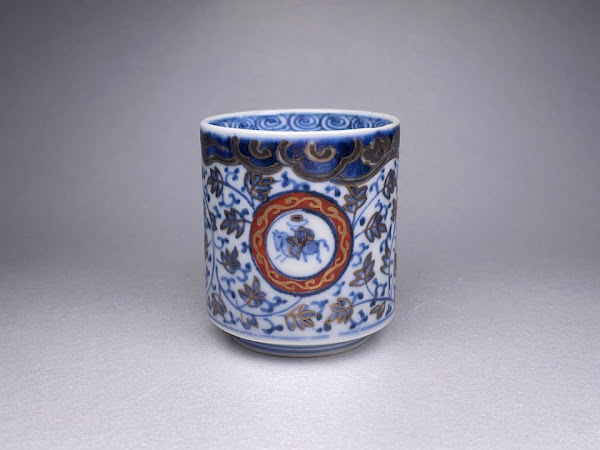平和島骨董まつり Heiwajima Antique Fair
先週末、平和島骨董まつりにいってきた。ホームページによると「全国古民具骨董まつり」として1978年にはじまったこの催しは、今回で184回目を迎え、日本各地の骨董商が多数参加する信頼と伝統の骨董市として親しまれている。わたしもこれまで5、6回は訪れている。ただでさえコロナウイルスの影響で人出が少ない中、3日間の会期の最終日の午後で、客はほんとうにまばらだった。以下、戦利品を紹介する。
I went to Heiwajima Antique Fair last weekend. It was the 184th fair beginning in 1978. More than two hundreds antique dealers gather from all over Japan, but this time the fair was substantially reduced because of the coronavirus crisis. Customers were very few as I went on the afternoon of the last day of the three-day session.
金彩染付 唐草馬上人物文 のぞき猪口 Nozoki Cup, Horse Rider Symbols
口径 top width: 54 mm / 高台径 bottom width: 42 mm / 高さ height: 61 mm
よくある萩唐草ののぞき猪口だが、丸文の内側に馬に乗った人の絵が描かれているのがおもしろい。人物はつばのついた帽子をかぶっており西洋人かもしれない(たとえば中島由美編、古伊万里蕎麦猪口・酒器1000、講談社、2001年)。染付の文様をさらに金彩で上書きしているが、このようなやりかたは古伊万里の器にしばしばみられる(たとえば瑠璃釉の上から金彩で文様をえがいたり)。こうした呉須+金彩の表現は得てしてケバケバしい感じを与えがちだが、この猪口にはむしろ落ち着きを感じる。赤絵の丸文が全体をひきしめているからかもしれない。のぞき猪口といえば縁の裏側は四方襷文様と相場が決まっているが、この猪口は簡略化された渦巻文様になっており、18世紀末以降の新様式を思わせる。いっぽうで大ぶりで堂々たる容姿はいかにも18世紀中葉のザ・のぞき猪口といった趣きである。
This kind of nozoki cup with arabesque pattern is not rare, but it is interesting that a person rinding a horse is drawn in a circle. It might be European because its broad-brimmed hat was not popular in Japan. The way of overpainting with gold on blue patterns is often seen in old Imari wares. The decoration with gold on this cup seems rather quiet to me. The whorl pattern behind the rim is, on one hand, characteristic in nozoki cups after the end of the 18th century. On the other hand, the size and shape remind me an older mid 18th century nozoki.
There are two circle patterns.
染付 唐人図 のぞき猪口 Nozoki Cup, Chinese Persons
口径 top width: 53 mm / 高台径 bottom width: 37 mm / 高さ height: 64 mm
中国人風の人物が3人、思い思いのポーズで立っている。いずれも童顔でかわいい。背景の文様は山を図案化したもの(いわゆる遠山文)だろう。配置がリズミカルで、ダミの濃淡とあいまってほんわかした感じを与える。見込みは五弁花。裾には鋸歯状のギザギザした文様がぐるりと描かれるが、骨董屋によるとこの意匠は上手作の古伊万里に多くみられるという。前掲の金彩染付唐草の猪口と大きさはおなじくらいだが、高台の比率がやや小さめで、ちょっとだけ古い手に属するかとおもう。
Three Chinese persons stand in various poses. Every face is boyish. The background pattern will be mountains. The dark and light blue colors give warm impression. There is a five-petal symbol at the bottom. A saw-tooth pattern is drawn over the cup's skirt, which is often seen in Imari wares of higher grade as the antique dealer said.
久しぶりにのぞき猪口らしいのぞき猪口を手に入れた。出会う骨董屋が口々に言うことだが、さいきんはいいのぞき猪口が出なくなった。


